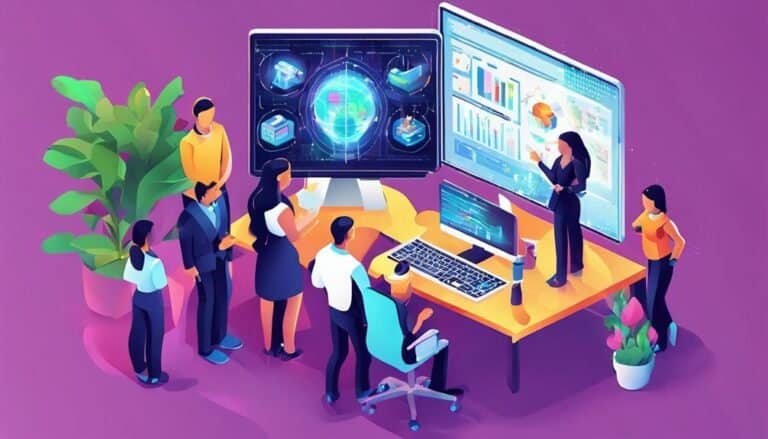AI and Climate Change: Tools for Sustainability
In the realm of combating climate change, the integration of Artificial Intelligence (AI) presents a promising avenue for fostering sustainability across various sectors.
From optimizing energy consumption to monitoring deforestation and biodiversity, AI offers a range of tools that can revolutionize our approach to environmental stewardship.
By harnessing the power of AI, organizations and governments can delve into a realm of possibilities that enhance our ability to mitigate the impacts of climate change.
The potential for AI to drive sustainable practices is vast, and its applications continue to evolve.
Key Takeaways
- AI enhances climate modeling accuracy and predictive capabilities.
- Optimizes energy usage for sustainability and efficiency.
- Improves renewable energy production through advanced algorithms.
- Enables real-time monitoring for biodiversity conservation and disaster resilience.
AI in Climate Modeling
Utilizing artificial intelligence algorithms in climate modeling enhances predictive accuracy and facilitates more nuanced analysis of complex environmental interactions. Climate modeling simulations are vital tools for understanding climate dynamics and predicting future scenarios.
AI weather forecasting, a subset of AI in climate modeling, has shown significant promise in improving the accuracy of weather predictions. By analyzing vast amounts of data, AI algorithms can identify patterns and correlations that traditional modeling techniques may overlook. This leads to more precise and timely weather forecasts, crucial for disaster preparedness and resource management.
AI in climate modeling also allows for the development of more sophisticated models that can simulate the intricate relationships between different environmental factors. These models enable researchers to explore various scenarios and assess the potential impacts of climate change with greater detail and accuracy. By incorporating AI into climate modeling, scientists can refine their understanding of complex climate systems and make more informed decisions to mitigate the effects of climate change.
The integration of AI technologies in climate modeling represents a significant step forward in our ability to address the challenges of a changing climate.
Optimizing Energy Consumption
In the realm of climate change mitigation, optimizing energy consumption through AI-driven strategies holds immense potential for enhancing sustainability efforts and reducing environmental impact. AI technologies can play a crucial role in revolutionizing energy management systems. Here are some key ways AI is optimizing energy consumption:
- Smart Grid Optimization: AI algorithms can analyze real-time data from smart grids to optimize energy distribution, reduce wastage, and enhance overall grid efficiency.
- Predictive Maintenance: By utilizing AI for predictive maintenance in energy infrastructure, organizations can identify and address potential issues before they escalate, ensuring smooth operations and minimizing energy losses.
- Occupancy-Based Energy Management: AI-powered systems can adjust lighting, heating, and cooling in buildings based on occupancy patterns, leading to significant energy savings in energy efficient buildings.
- Demand Response Optimization: AI can enable dynamic pricing strategies and demand response programs, encouraging consumers to shift their energy usage to off-peak hours, balancing energy supply and demand effectively.
- Optimized Energy Consumption in Industry: AI can optimize energy-intensive industrial processes, identifying opportunities for efficiency improvements and reducing energy consumption in manufacturing plants.
Enhancing Renewable Energy Production
Advancements in AI are revolutionizing the efficiency of solar panels by optimizing angles and tracking sunlight.
Wind turbine technology is benefitting from AI algorithms that predict optimal wind conditions, leading to increased energy production.
Furthermore, AI is enhancing hydroelectric power systems by predicting water flow and optimizing turbine operations for maximum output.
Solar Panel Efficiency
Maximizing solar panel efficiency is crucial in optimizing renewable energy production for a sustainable future. When it comes to enhancing solar panel efficiency, several key factors play a significant role:
- Panel Design: Innovative designs such as bifacial panels and solar tracking systems can maximize sunlight absorption.
- Energy Storage: Efficient energy storage solutions like lithium-ion batteries help store excess energy for later use.
- Material Quality: Using high-quality materials ensures durability and longevity of solar panels.
- Maintenance: Regular maintenance and cleaning are essential to keep panels operating at peak efficiency.
- Monitoring Systems: Implementing advanced monitoring systems allows for real-time performance tracking and optimization.
Wind Turbine Technology
Wind turbine technology represents a pivotal facet of the renewable energy landscape, offering innovative solutions for enhancing sustainable energy production.
Through the integration of smart maintenance systems, wind turbines can optimize their performance and operational efficiency. These systems utilize real-time data and predictive analytics to schedule maintenance tasks proactively, minimizing downtime and maximizing energy output.
Performance monitoring plays a crucial role in ensuring that wind turbines operate at peak capacity. By continuously analyzing key performance indicators such as energy production, vibration levels, and blade pitch angles, operators can identify potential issues early on and take corrective actions swiftly.
The combination of smart maintenance practices and performance monitoring not only improves the reliability of wind turbines but also contributes to the overall growth of renewable energy sources.
Hydroelectric Power Advancements
Hydroelectric power generation continues to evolve through technological innovations aimed at maximizing efficiency and expanding renewable energy capacity. Dam design plays a crucial role in enhancing hydroelectric power production, allowing for more efficient water flow and energy generation.
Sustainability practices in hydroelectric power advancements focus on minimizing environmental impact and promoting ecosystem health. Advanced monitoring systems enable real-time data analysis to optimize energy output and ensure operational reliability.
Innovations in turbine technology improve the overall efficiency of hydroelectric plants, making them more competitive in the renewable energy sector. By integrating these advancements, hydroelectric power continues to be a sustainable and reliable source of clean energy for the future.
- Dam design optimization
- Sustainability practices implementation
- Real-time monitoring systems
- Turbine technology advancements
- Energy output optimization
Improving Agricultural Practices
Utilizing advanced data analytics in conjunction with precision agriculture techniques has shown promising results in enhancing the sustainability and productivity of farming practices. Precision agriculture, a key component of sustainable farming, involves applying data-driven insights to optimize crop yields while minimizing resource inputs. Through the use of AI-powered tools, farmers can analyze soil conditions, weather patterns, and crop health in real-time, enabling them to make informed decisions that reduce waste and environmental impact.
By leveraging precision agriculture technologies, such as drones for aerial imaging and sensors for monitoring soil moisture levels, farmers can tailor their actions to specific areas of their fields, leading to more efficient resource allocation. This targeted approach not only increases the overall productivity of agricultural operations but also helps in reducing water usage, fertilizer runoff, and greenhouse gas emissions.
Innovative solutions like predictive analytics and machine learning algorithms further enhance the effectiveness of sustainable farming practices by providing predictive insights on crop performance and pest management. By integrating these technologies into agricultural workflows, farmers can make proactive decisions that promote long-term environmental sustainability while ensuring food security for future generations.
Monitoring Deforestation and Biodiversity
Utilizing AI for deforestation tracking technology enables real-time monitoring and analysis of forest cover changes, allowing for proactive conservation efforts.
Coupled with biodiversity preservation strategies driven by AI, such as species identification and habitat monitoring, a holistic approach to safeguarding ecosystems can be achieved.
Deforestation Tracking Technology
Advancements in deforestation tracking technology have revolutionized the monitoring of deforestation and biodiversity, providing crucial data for sustainability efforts. These technological tools offer precise insights into forest cover changes, aiding in conservation strategies.
Key features include:
- Real-time satellite imagery for immediate detection of deforestation activities.
- Machine learning algorithms to analyze vast amounts of data for identifying deforestation patterns.
- Geographic Information Systems (GIS) for mapping deforested areas and planning restoration projects.
- Integration with on-ground sensors for accurate monitoring of biodiversity hotspots.
- Automated alerts and notifications to facilitate prompt conservation actions.
Such innovations not only help combat deforestation but also support initiatives like forest restoration and carbon offsetting.
Biodiversity Preservation Strategies
Incorporating cutting-edge technology and data-driven approaches, biodiversity preservation strategies aim to monitor deforestation trends and biodiversity hotspots with precision and efficiency.
By utilizing AI algorithms and satellite imagery, experts can track changes in forest cover and identify areas requiring immediate attention for habitat restoration and species conservation. These tools enable real-time monitoring of deforestation activities, helping to combat illegal logging and land-use changes that threaten biodiversity.
Furthermore, machine learning models can analyze vast amounts of data to pinpoint biodiversity hotspots where targeted conservation efforts can have the most significant impact.
Through the combination of advanced technology and strategic conservation initiatives, biodiversity preservation strategies offer a proactive approach to safeguarding ecosystems and promoting sustainable coexistence between humans and nature.
Managing Water Resources
Water resource management is a critical component in the intersection of AI technology and efforts to address climate change, necessitating strategic planning and innovative solutions. When it comes to managing water resources, AI can play a pivotal role in optimizing usage and promoting sustainability. Here are some key areas where AI can make a significant impact:
- Predictive Analytics: AI can analyze data to predict water demand accurately, helping in efficient allocation and distribution.
- Smart Irrigation Systems: AI-powered systems can monitor soil moisture levels and weather conditions to optimize irrigation schedules, reducing water wastage.
- Leak Detection: AI algorithms can detect leaks in water infrastructure swiftly, preventing unnecessary water loss.
- Water Quality Monitoring: AI sensors can continuously monitor water quality parameters, ensuring the safety of water sources.
- Demand Response Management: AI can analyze consumption patterns and incentivize water conservation practices among consumers.
Enhancing Disaster Response and Resilience
In the realm of disaster response and resilience, the integration of AI technologies offers a transformative approach to mitigating risks and enhancing adaptive capacity. Disaster preparedness stands as a cornerstone in the effectiveness of response mechanisms. AI algorithms can analyze vast amounts of historical data to identify patterns and predict potential disaster scenarios, enabling authorities to proactively plan and allocate resources efficiently. Moreover, AI-powered systems can streamline communication and coordination among different response teams during crises, optimizing decision-making processes.
Community engagement plays a pivotal role in disaster resilience efforts. AI can facilitate community involvement by providing real-time information, personalized alerts, and tailored evacuation plans based on individual needs. Furthermore, AI technologies can assess structural vulnerabilities in buildings and critical infrastructure, helping communities prioritize retrofitting efforts to enhance their resilience to disasters.
Promoting Circular Economy
Amidst the advancements in disaster response facilitated by AI technologies, a pivotal shift towards promoting a circular economy emerges as a strategic imperative for sustainable development. In this context, leveraging AI for waste reduction and resource recycling plays a crucial role in fostering a more sustainable and environmentally friendly approach to economic activities.
Here are five key ways in which AI can promote a circular economy:
- Optimizing Recycling Processes: AI can enhance sorting processes in recycling facilities, improving efficiency and reducing contamination rates.
- Predictive Maintenance: AI-powered predictive maintenance can help prevent breakdowns in recycling machinery, ensuring continuous operation.
- Smart Supply Chain Management: AI analytics can optimize supply chains, reducing waste and promoting the reuse of resources.
- Consumer Behavior Analysis: AI can analyze consumer behavior patterns to encourage recycling practices and reduce waste generation.
- Circular Design: AI tools can aid in the design of products for easier disassembly and recycling, promoting a circular economy mindset from the outset.
Conclusion
In conclusion, AI tools offer promising solutions for addressing climate change and promoting sustainability across various sectors.
While some may argue that the implementation of AI technologies can lead to job displacement, it is crucial to acknowledge the urgent need for innovative approaches to combat the growing environmental challenges we face.
By harnessing the power of AI, we can work towards a more resilient and sustainable future for generations to come.







